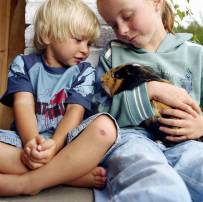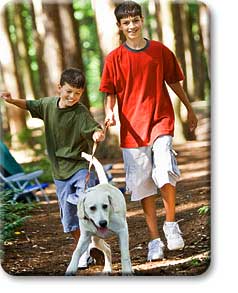“Pleeeeeeeeeeaaaaassssse?! He’s so cute! I promise I’ll look after him! I’ll do everything for him. He’ll be mine! You won’t have to do a thing! Please can we get him, Pleeeeeeeeeeaaaaassssse?!” A familiar sound at shelters, pet stores and adoption events, a child’s plea for a pet is cute (unless it’s a shrill cry) but as a parent you may be wondering – when is the right age for your young one to take care of an animal. What pet is right for him? Is he an appropriate age? Is he responsible enough? How much of the work am I going to end up with? Each child and family is different, but here are some guidelines to keep in mind before taking your little bi-ped to adopt a new quadruped family member. 
The ASPCA recommends different animals for different ages for first time little pet owners. Between the ages of three and five, your child is learning about contact and empathy. ASPCA experts recommend a guinea pig for a pet. “Guinea pigs like to be held, seldom bite and will whistle when excited or happy, to the delight of most kids. Your child can also help with responsibilities by filling the water bottle and food dish.” Of course, mom or dad will need to supervise playtime and make sure that the cage is washed properly.
 For five to ten year olds, small pets such as gerbils, rats, hamsters and fish are recommended for learning proper care and pet hygiene. This keeps the parent’s involvement (aka: work) to a minimum. Children at this age tend to have a short attention span. Keep watch that your child is giving clean water and is feeding the appropriate amount of food. They can help with chores such as cleaning the cage, washing the toys and measuring the food. These steps are vital before adopting larger pets that require more dedication. During this time of learning, your child is gaining confidence and a sense of responsibility which will bring them to the next step, if wanted.
For five to ten year olds, small pets such as gerbils, rats, hamsters and fish are recommended for learning proper care and pet hygiene. This keeps the parent’s involvement (aka: work) to a minimum. Children at this age tend to have a short attention span. Keep watch that your child is giving clean water and is feeding the appropriate amount of food. They can help with chores such as cleaning the cage, washing the toys and measuring the food. These steps are vital before adopting larger pets that require more dedication. During this time of learning, your child is gaining confidence and a sense of responsibility which will bring them to the next step, if wanted.
Tweens are generally known to  have the greatest interest in owning a dog or cat. They are mature enough to clean the litter box, and keep them watered and fed properly. For walking, they should not do so independently until they are typically over the age of 15. This is because kids under this age may not know how or be physically able to handle dangerous situations that may arise, such as unleashed dogs. Kids of this age group can also attend training classes for Pooch; a wonderful learning opportunity! This is an age of reliance but parents should still keep tabs on how the pet is doing in terms of hygiene and diet.
have the greatest interest in owning a dog or cat. They are mature enough to clean the litter box, and keep them watered and fed properly. For walking, they should not do so independently until they are typically over the age of 15. This is because kids under this age may not know how or be physically able to handle dangerous situations that may arise, such as unleashed dogs. Kids of this age group can also attend training classes for Pooch; a wonderful learning opportunity! This is an age of reliance but parents should still keep tabs on how the pet is doing in terms of hygiene and diet.
Once your child reaches teenage-dom, they tend to become very busy with extracurricular activities, friends, school, and more. The ASPCA mentions birds or fish for first-time-teen pet owners. Your rapidly growing and maturing “little ones” will soon find themselves going to college and leaving their nest. So, remember that any pet is a FOREVER pet and the parent may end up with Fido or Fluffy for a very long amount of time.
It is up to the parent to create and keep guidelines for their child. Sure, they may make the promises to feed, water, clean, play and care with those cute little faces at the shelter. However, the situation may turn into the parent taking all the responsibility once the child finds out that it’s not all fun and games to own a pet. A great way to build trust that your child will take care of their pet is for them to use their allowance money to purchase treats, beds and toys. GlobalAnimal.org says that immediate positive reinforcement is a perfect and productive way to praise your child for a job well done; more confidence boosting and a feeling of responsibility. An outline to read with your child can be found here. No matter what and when your child decides to take on a new pet, it is the family’s duty to make sure that the pet is well looked after; it’s just a matter of how much time and effort everyone is willing to dedicate.